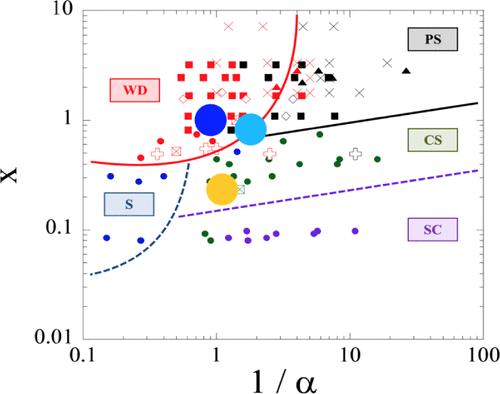The Payne Effect in Nanofilled Cross-Linked Polyisoprene
IF 5.2
1区 化学
Q1 POLYMER SCIENCE
引用次数: 0
Abstract
We present a systematic study of the Payne effect, i.e., the difference between the small- and large-amplitude oscillatory shear response of filled elastomers, which is relevant to the performance of tires under dynamic driving conditions. The elastomers consist of 14-nm-diameter spherical silica nanoparticles (NPs) grafted with polyisoprene chains, mixed with polyisoprene matrices, and subsequently cross-linked into the gel state. By changing the grafting density and the ratio of the graft-to-matrix chain length, we vary the NP assembly state and examine its response to large-amplitude oscillations. We find that the Payne effect is present at all filler contents but becomes more pronounced at higher NP loadings and for the connected sheet morphology, with the well-dispersed NP state showing the smallest effect. The key concept that apparently controls the strength of the Payne effect is that the core–core contacts are stronger but more fragile compared to interdigitated grafts. Therefore, to achieve increased modulus but reduced Payne effect, a compromise between enhanced NP core interactions and the interdigitation of grafts with other grafts and with the matrix chains is needed. This compromise is best achieved for a morphology intermediate between these two extremes, i.e., a connected network morphology.

纳米填充交联聚异戊二烯的Payne效应
我们系统地研究了Payne效应,即填充弹性体的小振幅和大振幅振荡剪切响应之间的差异,这与轮胎在动态驾驶条件下的性能有关。弹性体由直径为14nm的球形二氧化硅纳米颗粒(NPs)接枝聚异戊二烯链,与聚异戊二烯基质混合,然后交联成凝胶态。通过改变接枝密度和接枝与基体链长之比,我们改变了NP组装状态,并研究了其对大振幅振荡的响应。我们发现佩恩效应存在于所有填料中,但在高NP负载和连接片形态下变得更加明显,分散良好的NP状态显示出最小的影响。明显控制佩恩效应强度的关键概念是,与指间接枝相比,核心-核心接触更强,但更脆弱。因此,为了增加模量但减少Payne效应,需要在增强的NP核相互作用和接枝与其他接枝以及与矩阵链的交叉之间达成妥协。这种折衷最好是在这两个极端之间的形态中实现的,即连接的网络形态。
本文章由计算机程序翻译,如有差异,请以英文原文为准。
求助全文
约1分钟内获得全文
求助全文
来源期刊

Macromolecules
工程技术-高分子科学
CiteScore
9.30
自引率
16.40%
发文量
942
审稿时长
2 months
期刊介绍:
Macromolecules publishes original, fundamental, and impactful research on all aspects of polymer science. Topics of interest include synthesis (e.g., controlled polymerizations, polymerization catalysis, post polymerization modification, new monomer structures and polymer architectures, and polymerization mechanisms/kinetics analysis); phase behavior, thermodynamics, dynamic, and ordering/disordering phenomena (e.g., self-assembly, gelation, crystallization, solution/melt/solid-state characteristics); structure and properties (e.g., mechanical and rheological properties, surface/interfacial characteristics, electronic and transport properties); new state of the art characterization (e.g., spectroscopy, scattering, microscopy, rheology), simulation (e.g., Monte Carlo, molecular dynamics, multi-scale/coarse-grained modeling), and theoretical methods. Renewable/sustainable polymers, polymer networks, responsive polymers, electro-, magneto- and opto-active macromolecules, inorganic polymers, charge-transporting polymers (ion-containing, semiconducting, and conducting), nanostructured polymers, and polymer composites are also of interest. Typical papers published in Macromolecules showcase important and innovative concepts, experimental methods/observations, and theoretical/computational approaches that demonstrate a fundamental advance in the understanding of polymers.
 求助内容:
求助内容: 应助结果提醒方式:
应助结果提醒方式:


